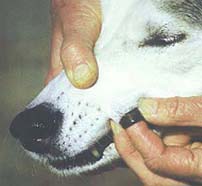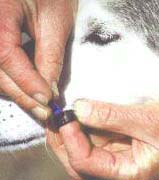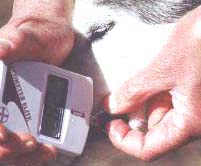|
When I first read about
getting blood from the dog's lip, I assumed it was from the outside of
the lip. Not until I had been doing this for months, did I realize that
most people were using the inside of the lip. By that time, I had done
hundreds of successful sticks without objection from Bayou and, therefore,
saw no reason to change my technique. The one advantage I see with sticking
the outside as opposed to the inside of the lip is that I never have the
problem of saliva mixing with the blood. Bayou, a Siberian Husky, usually
stands for the operation. I straddle her back, my knees pressed gently
into her sides to hold her in place. However, the procedure can also be
done with the dog lying down. I use the lancet manually, but I assume the
lancing device could be used as well. Here is the routine in detail:
Step 1.
The equipment should be prepared in advance, ready
for use. The test strip wrapping should be opened, but the strip not yet
inserted into the meter. The lancet device should be loaded, or if using
the lancet manually, the cap twisted off the lancet. The meter, test strip,
lancet and a facial tissue should be placed within easy reach. |
Step 2.
Just before you are ready to get blood, insert the
test strip into the meter. |
Step 3.
The dog should be in a relaxed position. Slip the
index finger of the left hand (if you are right-handed) under the upper
left lip of the dog, move the finger upwards in order to stretch the skin
of the lip. Hold the taut skin in place by positioning the thumb and the
middle finger on the outside of the lip adjacent to the index finger. That
portion of the lip is now partially wrapped around the index finger. This
is very important: The skin of the lip must be taut. If it is not, jabbing
the lip with the lancet would be like jabbing into a soft rubber ball. |
 |
Step 4.
Once the lip skin is taut, make a very quick jab.
With a fresh lancet and stretched skin, the jab does not need to be very
forceful, but it should be a quick jab instead of a gentle push. |
 |
Step 5.
After the jab release the lip entirely and put down
the lancet or device. With a gentle squeezing motion, using both hands,
look for the bead of blood. Sometimes it's there immediately, even before
putting down the lancet, in which case you grab the meter immediately.
Sometimes you have to squish the lip around to find the puncture. Good
lighting is essential, especially if the bead of blood doesn't appear immediately.
If there isn't enough blood at first, milk the area very gently until enough
blood comes up. Then hold the dog's face and lip steady, slip the index
finger again inside the lip under the spot where the bead appears, and
hold it in place with the thumb on the outside. |
 |
Step 6.
Pick up the meter into which the test strip has
already been inserted, and hold it on to the bead until enough blood has
been wicked up. |
 |
Step 7.
Clean the puncture area with the facial tissue. |
It doesn't matter where on the lip the blood is taken.
Usually it's somewhere towards the middle. Sometimes I've jabbed close
to the hair on the muzzle, but the hair didn't cause a problem. Bayou's
whiskers get in the way from time to time, but that doesn't matter either.
This procedure sounds perhaps complicated, but it
is really very easy if the animal is relaxed and cooperates. The instructions
read as if the procedure takes forever, but the whole thing is over in
less than 30 seconds.
--Contributed by Joan and Bayou

     
Updated August 2001
Copyright. All rights reserved.
This site is
for information purposes only. Please consult your veterinarian.
|
 Outside
Lip Prick for Obtaining Blood from a Dog
Outside
Lip Prick for Obtaining Blood from a Dog Outside
Lip Prick for Obtaining Blood from a Dog
Outside
Lip Prick for Obtaining Blood from a Dog